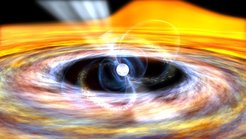Compact Binary Evolution

A brandnew class of radio transients of unknown origin may be connected to some of these events. Binary stars relate to neutron stars in particular through accretion processes in X-ray binaries and the formation of millisecond pulsars. These form when a neutron star is spun up to high rotational frequencies via accretion of mass and angular momentum from a companion star in a close binary. Their observed orbital and stellar properties are fossil records of their evolutionary history and hence binary pulsar systems are key probes of stellar astrophysics and the related forces and interactions of stellar matter at work. The collaboration with Prof. Langer’s Stellar Physics group at the Argelander Institute for Astronomy at University of Bonn provides a unique combination of theoretical and observational expertise and an opportunity to use binary stellar laboratories for studying fundamental physics.
Recycling pulsars
Millisecond pulsars are the link between the evolution of massive stars, binary stars, X-ray astronomy and gravitational waves. During their spin-up phase the binary is bright in X-rays as a result of plasma being heated when it falls toward the neutron star. Many aspects of the basic physics in millisecond pulsar formation are not well understood, e.g. the accretion efficiency, the decay of magnetic fields of the neutron star, the evolution of a common envelope and the momentum kick associated with the birth of neutron stars. Part of our research is focused on the accretion physics leading to so-called equilibrium spin and the final masses and true ages of recycled pulsars. We have demonstrated that a braking torque acts on a neutron star, when the companion star decouples from its Roche lobe, leading to dissipation of >50% of the rotational energy of the pulsar - an effect which may explain the apparent difference in observed distributions of rotation periods between accreting X-ray and radio millisecond pulsars.
